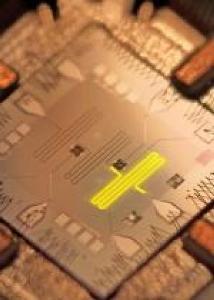Feb 2 2011
Inspired by the popular confidence trick known as "shell game," researchers at UC Santa Barbara have demonstrated the ability to hide and shuffle "quantum-mechanical peas" –– microwave single photons –– under and between three microwave resonators, or "quantized shells."
In a paper published in the Jan. 30 issue of the journal Nature Physics, UCSB researchers show the first demonstration of the coherent control of a multi-resonator architecture. This topic has been a holy grail among physicists studying photons at the quantum-mechanical level for more than a decade.
 The photon shell game architecture: Two superconducting phase qubits (squares in the center of the image) are connected to three microwave resonators (three meander lines).
The photon shell game architecture: Two superconducting phase qubits (squares in the center of the image) are connected to three microwave resonators (three meander lines).
The UCSB researchers are Matteo Mariantoni, postdoctoral fellow in the Department of Physics; Haohua Wang, postdoctoral fellow in physics; John Martinis, professor of physics; and Andrew Cleland, professor of physics.
According to the paper, the "shell man," the researcher, makes use of two superconducting quantum bits (qubits) to move the photons –– particles of light –– between the resonators. The qubits –– the quantum-mechanical equivalent of the classical bits used in a common PC –– are studied at UCSB for the development of a quantum super computer. They constitute one of the key elements for playing the photon shell game.
"This is an important milestone toward the realization of a large-scale quantum register," said Mariantoni. "It opens up an entirely new dimension in the realm of on-chip microwave photonics and quantum-optics in general."
The researchers fabricated a chip where three resonators of a few millimeters in length are coupled to two qubits. "The architecture studied in this work resembles a quantum railroad," said Mariantoni. "Two quantum stations –– two of the three resonators –– are interconnected through the third resonator which acts as a quantum bus. The qubits control the traffic and allow the shuffling of photons among the resonators."
In a related experiment, the researchers played a more complex game that was inspired by an ancient mathematical puzzle developed in an Indian temple called the Towers of Hanoi, according to legend.
The Towers of Hanoi puzzle consists of three posts and a pile of disks of different diameter, which can slide onto any post. The puzzle starts with the disks in a stack in ascending order of size on one post, with the smallest disk at the top. The aim of the puzzle is to move the entire stack to another post, with only one disk being moved at a time, and with no disk being placed on top of a smaller disk.
In the quantum-mechanical version of the Towers of Hanoi, the three posts are represented by the resonators and the disks by quanta of light with different energy. "This game demonstrates that a truly Bosonic excitation can be shuffled among resonators –– an interesting example of the quantum-mechanical nature of light," said Mariantoni.
Source: http://www.ucsb.edu/